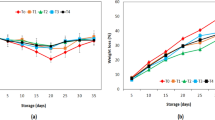Summary
In the present studies, distinct variations for chemical characters were obtained. The juice obtained from the grains of Tree No. 23 and 4 was highly red coloured followed by Tree Nos. 5, 21 and 26. The sugar to acid ratio was maximum in Tree No. 22 followed by Tree Nos. 16 and 23.
Similar content being viewed by others
References
A.O.A.C., 1970. Official Methods of Analysis, Association of official Agricultural Chemists, Washington, D.C., USA.
Goor, A. & J. Liberman, 1956. The Pomegranate. Bulletin of the Ministry of Agriculture, Israel pp. 57.
Malhotra, H.K., H.H. Khajuria & J.S. Jawanda, 1983. Studies on physico-chemical characteristics of pomegranate cultivars. Punjab Hort. Jour. 23: 153–161.
Nasacheva, E.P., K.I. Anisimova & S.D. Shteinbok, 1973. Tannins in the rind (pericarp) of pomegranate fruit and prospects of utilization by the tannin industry. Rastitelinyl Resursy 9 (2): 267–60.
Parmar, C. & M.K. Kaushal, 1982. Wild fruits of Sub-Himalayan Region. Kalyani Publishers. New Delhi-Ludhiana pp. 74–77.
Pundir, J.P.S. & S.P. Pathak, 1980. Morphological characters and chemical composition of fruits of four pomegranate cultivars. Udyanica 4 (1–2): 23–24.
Siddappa, G.S., 1943. Pomegranate juice. Ind. Fmg. 4: 196–198.
Author information
Authors and Affiliations
Rights and permissions
About this article
Cite this article
Sharma, S.D., Sharma, V.K. Variation for chemical characters in some promising strains of wild pomegranate (Punica granatum L.). Euphytica 49, 131–133 (1990). https://doi.org/10.1007/BF00027262
Received:
Accepted:
Issue Date:
DOI: https://doi.org/10.1007/BF00027262




